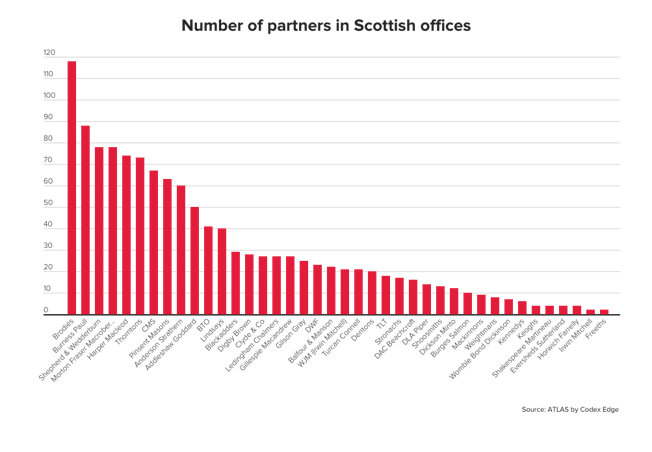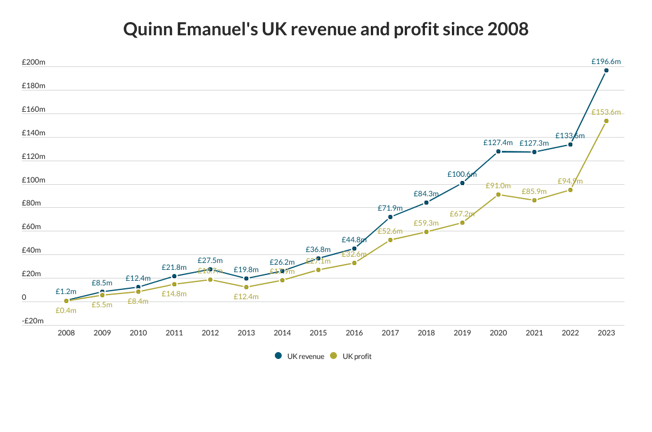
It’s just a couple of days to go before the end of the financial year. Simmons & Simmons’ new managing partner Mark Dawkins is sitting in the canteen trying not to grin. But his pleasure is all too obviously tempered by relief.
Simmons is off the critical list – for now. After four years of woeful results, the firm is about to celebrate an astonishing turnaround, with projected average profits per partner (PEP) up 35 per cent to £371,000 from last year’s £275,000. With a few days more billing to go, there is even hope that the firm will make the magic £400,000 PEP figure, the apparently impossible target it set itself this time last year.
“It’s a good start,” says Dawkins, who then collects himself. “But it’s just a start.”
Back to basics
One of the reasons Dawkins was elected unopposed at the end of last year was his track record in the finance department, which he previously headed. In 2002-03, that group was the firm’s most profitable in London by some way, with average PEP well over £100,000 above the firm’s average.
A similar back to basics approach initiated by his predecessor David Dickinson yielded results across the firm this year. Simmons’ profit rise is down to a combination of circumstances. First, internal pruning with a round of de-equitisations, which saw at least 11 partners move. Second, simple housekeeping – some £2m in costs were saved off the London salary bill alone last year, says Dawkins. Third, and most importantly, revenue per equity partner started to rise, from £1.1m to £1.3m. De-equitisations will help that figure, but the indications are that revenue growth has come from more productive teams – the firm’s turnover is up some 10 per cent to nearly £200m this year.
But can Simmons maintain its momentum? Dawkins is only partly joking when he says he has to achieve as much as possible in his first 100 days in office. A turnaround has to be based on sound planning.
The fact is that Simmons had to do something. This time last year the firm was probably at its lowest ebb. Average PEP had fallen to £275,000, putting it 48th in the profits table, according to The Lawyer UK 100 Annual Report. Simmons lagged behind Davies Arnold Cooper, Denton Wilde Sapte, Dickinson Dees, Field Fisher Waterhouse and Osborne Clarke, to name just a few. A number of junior equity partners, whose take had dipped to £140,000, were being paid significantly less than some salaried partners.
A few months into the financial year 2004-05 and the partner resignations started happening – although some of those departures were managed. Then there was the unpleasant episode of one of the firm’s own equity partners, Robert Schon, suing the partnership for alleged race discrimination. The dispute has since been settled.
Dawkins is entirely unsentimental about the firm’s culture. He says: “We’ve never sought to communicate what we are except saying we’re friendly, which doesn’t butter any parsnips when it comes to winning work.”
Simmons partners like to look back fondly on the days of 2000-01, when the firm managed a record £412,000. But there is a strong argument that the 2001 figure was a flash in the pan. Simmons has always been a City name, but high profile never translated into high profits.
Nowadays the £400,000 PEP bracket is where any firm with ambition is inhabiting. Simmons’ competition in this sphere includes Addleshaw Goddard, CMS Cameron McKenna, Nabarro Nathanson and Norton Rose, all of which are chasing the quality mid-market. Meanwhile, SJ Berwin, BLP and Travers Smith will be attaining average PEP of over £500,000. Simmons has a way to go.
Some of the groundwork has already been put in. Dawkins is quick to praise his predecessor Dickinson for hiking the quality of the firm’s client base. A decade ago the biggest clients would have been Brent Walker Group, the Ministry of Defence (MoD) and Railtrack. Now its top clients by revenue still include the MoD and Network Rail, but also Barclays, Credit Suisse First Boston, GlaxoSmithKline, JPMorgan, Shell and UBS.
However, Dawkins has strong words about the malaise that afflicted the partnership for so long. “We’ve always been slow to manage the costs side of the equation,” he says. Indeed, the statistics are telling. According to The Lawyer UK 100 Annual Report, the firm grew turnover by 52 per cent over the last five years – but average profit by only 8 per cent.
“That partly reflects the culture of the firm,” Dawkins continues. “I want the firm to be more challenging. Our friendly image costs us money. I don’t want us to be aggressive or confrontational, but I do want us to be more challenging to ourselves.”
This hard-headed approach underlies Simmons’ radical thinking on working practices, revealed by The Lawyer earlier this year. The firm is taking as a model a quasi-freelance philosophy used at major consultancies, says Dawkins.
The way Dawkins describes it, it is just like a yearly budgeting process – except it is centred around time, not income. After consultation with business group heads, employees can enter a contract negotiation with the firm and opt for a certain amount of working time. When they are in work, they will be expected to commit fully (“50 hours a week if necessary,” notes Dawkins). If employees want three months off, and if that can be accommodated by the business, then that will be sanctioned – but they are not paid for any time off.
This initiative is all part of a general re-engineering of the practice, says Dawkins, who is clearly more comfortable talking about practice areas and client reach than flexible working. “We’ve had a chequered history,” he admits. “We’ve been reliant in the past on big jobs and in [some corporate areas] have left it 10 years too late.”
Simmons had obviously laboured under delusions of grandeur left over from the early 1990s, before the emergence of a delineated magic circle. Dawkins is sure, though, that his partners have woken up to this now, and he talks about a generational shift within the corporate department. He cites younger partners such as Ed Baker, Selina Sagayam, Mark Curtis and Richard May, to name but a few, as being part of a group now leading the charge.
“They’re succeeding by being realistic and looking at slightly smaller houses like ABN, Collins Stewart and Lazard,” he says.
Damon Le Maitre George, Simmons’ new head of corporate, says that his group’s turnover is up some 20 per cent. “We’ve done a much better job at bringing work in,” he says simply.
To a large extent, the turnaround started on the award-winning Northumbrian Water deal with Collins Stewart – the first ever accelerated IPO that also happened to kickstart the AIM sector two years ago.
The corporate group used that to open doors at a clutch of financial institutions such as Deutsche Bank and ABN Amro’s broking arm Hoare Govett.
But within several months, Travers Smith soon started catching up, doing similar deals with Evolution Beeson Gregory and Numis. And there lies the problem. Momentum is critical, or Simmons will lose market share again to more aggressive mid-market practices. And Simmons managed a clutch of AIM floats in 2004 – but only eight in total, lagging behind Norton Rose (19) and BLP (16).
Keeping everything together
Within just a few weeks of assuming his position, Dawkins was already shaking up the management structure. He got approval to form an international executive, which took account of overseas offices for the first time.
“As the firm has grown internationally, we had a management vacuum between the board and the firm, which made implementation difficult. The executive was just London-based,” he says. “It’s hugely important if we’re going to make the most of our network. There’s a lot more that can be done on integration on an operational and client level.”
Looking at Simmons’ international spread, you can see why Dawkins is so concerned about network integration.
More than 50 per cent of Simmons’ turnover is now generated overseas. Dawkins maintains that there is massive growth potential in Asia and the Middle East, but there are still doubts about Simmons’ European offering. Italy is a notoriously unstable legal market: despite Simmons’ longevity in Milan, it has still lost a series of partners. Paris is tiny. The Netherlands is arguably too large; it has 36 partners compared to 44 across the rest of Continental Europe. Germany has hiccuped its way to eight partners, but there must remain doubts that it is ill-resourced to service all the London practice’s needs. Dawkins is going to have to address considerable management time to its less mature Continental businesses.
“We’ve been in a squeeze, and that’s going to get worse [for firms like us]. Some will dwindle and fail. Some will succeed.” Stark words. But it’s refreshing to find a Simmons partner who doesn’t mention the art collection.





























